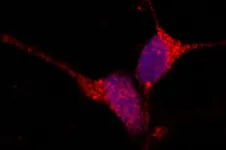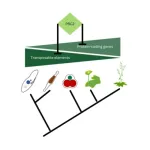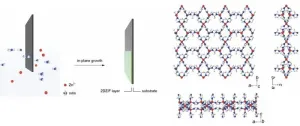(Press-News.org) It sounds like magic: photoelectrodes could convert the greenhouse gas CO2 back into methanol or N2 molecules into valuable fertiliser - using only the energy of sunlight. An HZB study has now shown that diamond materials are in principle suitable for such photoelectrodes. By combining X-ray spectroscopic techniques at BESSY II with other measurement methods, Tristan Petit's team has succeeded for the first time in precisely tracking which processes are excited by light as well as the crucial role of the surface of the diamond materials.
At first glance, lab-grown diamond materials have little in common with their namesakes in the jewellery shop. They are often opaque, dark and look not spectacular at all. But even if their looks are unimpressive, they are promising in many different applications, for example in brain implants, quantum sensors and computers, as well as metal-free photoelectrode in photo-electrochemical energy conversion. They are fully sustainable and made of carbon only, they degrade little in time compared to metal-based photoelectrodes and they can be industrially produced!
Diamond materials are suitable as metal-free photoelectrodes because when excited by light, they can release electrons in water and trigger chemical reactions that are difficult to initiate otherwise. A concrete example is the reduction of CO2 to methanol which turns the greenhouse gas into a valuable fuel. It would also be exciting to use diamond materials to convert N2 into nitrogen fertiliser NH3, using much less energy than the Haber-Bosch process.
However, diamond electrodes oxidize in water and oxidized surfaces, it was assumed, no longer emit electrons into the water. In addition, the bandgap of diamond is in the UV range (at 5.5 eV), so visible light is unlikely to be sufficient to excite electrons. In spite of this expectation, previous studies have shown puzzling emission of electrons from visible light excitation. A new study by Dr. Tristan Petit's group at HZB now brings new insights and gives cause for hope.
Dr Arsène Chemin, a postdoctoral researcher in Petit's team, studied samples of diamond materials produced at the Fraunhofer Institute for Applied Solid State Physics in Freiburg. The samples were engineered to facilitate the CO2 reduction reaction: doped with boron to insure good electrical conductivity and nanostructured, which gives them huge surfaces to increase the emission of charge carriers such as electrons.
Chemin used four X-ray spectroscopic methods at BESSY II to characterize the surface of the sample and the energy needed to excite specific electronic surface states. Then, he used the surface photovoltage measured in a specialised laboratory at HZB to determine which ones of these states are excited and how the charge carriers are displaced in the samples. In complement, he measured the photoemission of electrons of samples either in air or in liquid. By combining these results, he was able for the first time to draw a comprehensive picture of the processes that take place on the surfaces of the sample after excitation by light.
"Surprisingly, we found almost no difference in the photoemission of charges in liquid, regardless of whether the samples were oxidized or not," says Chemin. This shows that diamond materials are well suited for use in aqueous solutions. Excitation with visible light is also possible: in the case of the boron-doped samples, violet light (3.5 eV) is sufficient to excite the electrons.
"These results are a great cause for optimism," says Chemin: "With diamond materials we have a new class of materials that can be explored and widely used." What’s more, also the methodology of this study is interesting: The combination of these different spectroscopic methods could also lead to new breakthroughs in other photoactive semiconductor materials, the physicist points out.
END
Diamond materials as solar-powered electrodes - spectroscopy shows what's important
2023-09-21
ELSE PRESS RELEASES FROM THIS DATE:
How do toxic proteins accumulate in Alzheimer’s and other diseases?
2023-09-21
Under normal circumstances, tau protein is part of the brain’s infrastructure, important for stabilizing neurons into their proper shapes. But sometimes tau gets knotted up into tangles and turns toxic, injuring brain tissue and causing tauopathies, a group of brain diseases characterized by problems with learning, memory and movement. Alzheimer’s disease is the most common tauopathy, but the group also includes Parkinson’s disease, chronic traumatic encephalopathy (CTE) and several rare genetic conditions.
In search of ways to prevent these destructive ...
Study details immune cells vital to success of vaccines against coronavirus
2023-09-21
A study has revealed new details about a key population of immune system cells critical to successful vaccination against the pandemic virus, SARS-CoV-2.
Led by researchers at NYU Grossman School of Medicine and New York Genome Center, the current study focused on T cells, which along with B cells, compose the human immune system’s response to invading viruses and bacteria. A subset of T cells, labeled with the surface protein CD8, produce molecules that directly kill infected cells. B cells produce antibody proteins that neutralize and label infected cells for removal from the body.
Without risking ...
University of Cincinnati research examines the molecular mechanism of psychological loss
2023-09-21
Psychological loss can occur when someone loses a job, loses a sense of control or safety or when a spouse dies. Such loss, which erodes well-being and negatively impacts quality of life, may be a common experience but little is known about the molecular process in the brain that occurs because of loss.
New research from the University of Cincinnati explores those mechanisms through a process known as enrichment removal (ER). The study highlights an area of the brain that plays a key role in psychological loss and identifies new molecular targets that may alleviate its impact.
The research was published in the journal Molecular Psychiatry.
The research was led by Marissa Smail, a ...
Cardiff University chooses Figshare as integral part of research data management strategy
2023-09-21
Digital Science, a technology company serving stakeholders across the research ecosystem, is pleased to announce that Cardiff University has chosen Figshare from Digital Science’s flagship products to enhance its researcher support services, as it continues its work as a leading research institution.
Cardiff University – already excelling in the production of high-quality, innovative research that translates into benefits for the city, Wales and worldwide – has signed a two-year deal to utilize Figshare as its data repository and to form an integral ...
MD Anderson Research Highlights for September 21, 2023
2023-09-21
HOUSTON ― The University of Texas MD Anderson Cancer Center’s Research Highlights showcases the latest breakthroughs in cancer care, research and prevention. These advances are made possible through seamless collaboration between MD Anderson’s world-leading clinicians and scientists, bringing discoveries from the lab to the clinic and back.
Understanding the role of exceptional research as a driving force behind progress in its mission to end cancer, MD Anderson is proud to support World Cancer Research Day, Sept. 24, which calls for global efforts to promote cancer ...
Incidence of diabetes among youth before and during the pandemic
2023-09-21
About The Study: In this study that included data from Kaiser Permanente Southern California of individuals age 19 and younger, the incidence of type 1 diabetes slightly increased overall and type 2 diabetes significantly increased after the beginning of the COVID-19 pandemic, in particular among non-Hispanic Black and Hispanic youth. These findings suggest the need for further evaluation of physiologic and behavioral risk factors preceding new-onset diabetes during the pandemic.
Authors: Matthew T. Mefford, Ph.D., of Kaiser Permanente Southern ...
Disparities in emergency medicine residents’ performance assessments by race, ethnicity, and sex
2023-09-21
About The Study: This analysis of assessments of 2,708 emergency medicine residents found evidence of sex-specific ethnoracial disparities in ratings on the Milestones assessments. These disparities increased over time across multiple Milestones assessments and were most severe for female residents of ethnoracial groups that are underrepresented in medicine.
Authors: Elle Lett, Ph.D., M.A., M.Biostat., of the University of Washington School of Public Health in Seattle, is the corresponding author.
To ...
New origin story for key regulatory gene
2023-09-21
Polycomb repressive complex 2 (PRC2) was discovered decades ago in Drosophila, where it was found to be a key controller of developmental genes. Further analyses showed that PRC2 modifies chromatin and silences target gene expression. However, the ancestral function of PRC2 - as functioning primarily to control genes during development - was called into question when researchers discovered that PRC2 also plays a role in unicellular species, in which no development takes place. A first hint at PRC2’s original role came from studies in red algae, which found PRC2 left its methylation mark on transposons – jumping genes that ...
Ultrathin films achieve record hydrogen-nitrogen separation
2023-09-21
Metal-organic frameworks (MOFs) are a class of materials that contain nano-sized pores. These pores give MOFs record-breaking internal surface areas, which make them extremely versatile for a number of applications: separating petrochemicals and gases, mimicking DNA, producing hydrogen, and removing heavy metals, fluoride anions, and even gold from water are just a few examples.
In the gas-separation domain, MOFs are particularly interesting for separating hydrogen from nitrogen, which is crucial for clean energy production, fuel cell efficiency, ammonia synthesis, and various ...
Getting ready for bed controlled by specific brain wiring in mice
2023-09-21
The team, led by Imperial College London researchers, uncovered the wiring in mouse brains that leads them to begin nesting in preparation for sleep. Published today in Nature Neuroscience, the study reveals that preparing properly for sleep is likely a hard-wired survival feature – one often neglected or overridden by humans.
We all need to sleep, but since we are unconscious when we do so, it makes sense to fall asleep in a safe and warm place. For some animals this is especially important, as a burrow or nest provides a haven from ...





